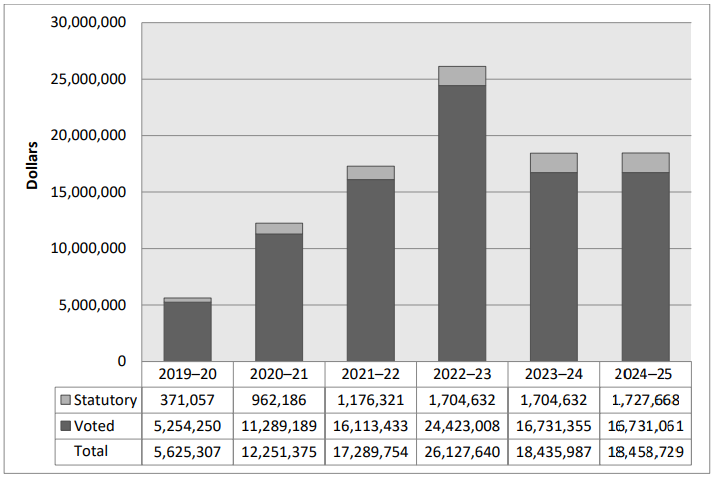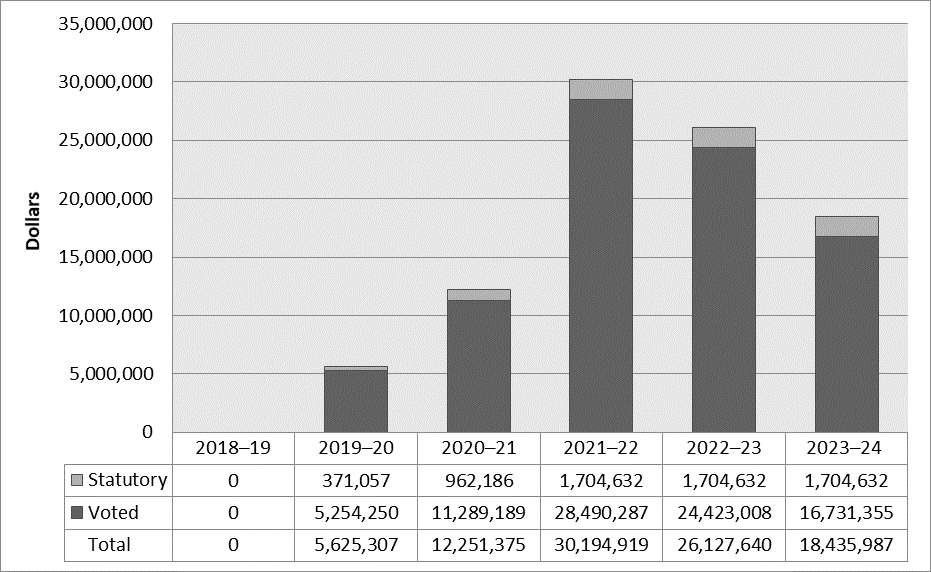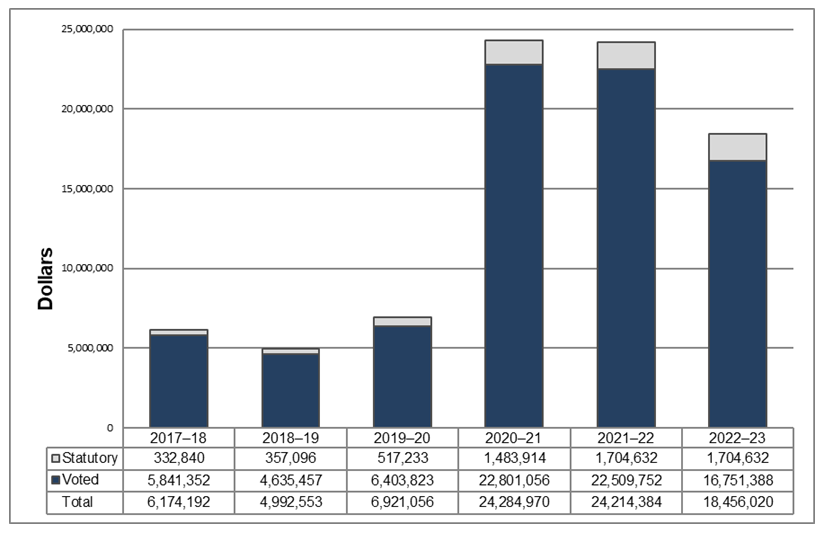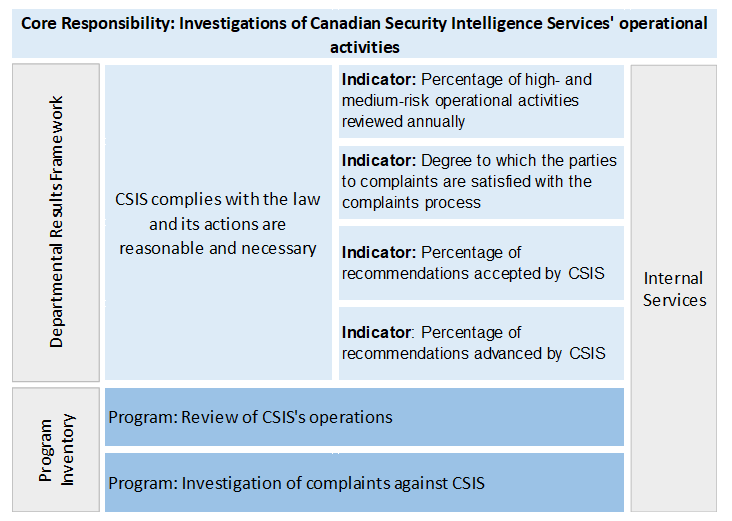Meta data information
Cat. Number: PS106-8E-PDF
ISSN: 2563-5174
© His Majesty the King in Right of Canada, 2023
Date of Publishing:
From the Executive Director
I am pleased to present the National Security and Intelligence Review Agency (NSIRA) Secretariat’s Departmental Results Report for 2022-23. Throughout the reporting period, the Secretariat has continued to execute its mission to support NSIRA in its focus on conducting highquality, impactful reviews and fair and efficient complaint investigations. We also worked to expand our capacity and expertise across all business lines, building on the work of previous years.
In 2022-23, NSIRA’s review work continued to expand to new areas within Canada’s national security and intelligence community and NSIRA continued to collaborate and de-conflict with like-minded accountability bodies in Canada with similar mandates. NSIRA’s work on complaint investigations was extensive and included the completion of a significant volume of referrals from the Canadian Human Rights Commission. The NSIRA Secretariat was an integral part of all of these developments which required us to remain agile, diverse and to explore all avenues of our productivity in the support of NSIRA.
Internally, we undertook a number of ambitious initiatives related to training and development, with a focus on attracting and retaining highly professional staff and offering career progression options. We continued to refine our business processes to enhance the quality of our output and strengthened our relationship with our various domestic and international counterparts to exchange on best practices in the field of national security and intelligence accountability.
I would like to thank all NSIRA Secretariat staff for their continued dedication to fulfilling our important mandate, and for ensuring that our work is held to the highest standards.
John Davies
Executive Director
National Security and Intelligence Review Agency
Results at a glance
In 2022-23, the National Security and Intelligence Review Agency (NSIRA) Secretariat continued to execute its mandate of assisting NSIRA in its Reviews and Investigations with the goal of improving national security and intelligence accountability and transparency in Canada. This related not only to the activities of the Canadian Security Intelligence Service (CSIS) and the Communications Security Establishment (CSE), but also other federal departments and agencies engaged in such activities, including:
- the Department of National Defence (DND) and the Canadian Armed Forces (CAF);
- the Canada Border Services Agency (CBSA); and,
- all departments and agencies engaging in national security and intelligence activities in the context of NSIRA’s yearly reviews of the Security of Canada Information Disclosure Act and the Avoiding Complicity in Mistreatment by Foreign Entities Act.
The NSIRA Secretariat’s total spending in 2022-23 amounted to $18,289,147 and its total actual full-time equivalents were 78.
Review
NSIRA’s review of national security and intelligence activities undertaken by Government of Canada institutions ensures that ministers and Canadians are informed about whether these activities were lawful, reasonable and necessary.
During 2022–23, the Secretariat assisted NSIRA in completing 7 reviews, including reviews of activities that were never previously subject to independent scrutiny. We also refined our methodology, emphasizing a stronger role for NSIRA Members in working with staff to shape reviews throughout their lifecycle.
Complaint investigations
In 2022-23 the Secretariat assisted NSIRA in the continuation of maturation and modernization of the processes underpinning the fulfillment of its investigation mandate. The jurisdiction assessment phase was regularized, incorporating a verification protocol for the three agencies for which NSIRA has complaints jurisdiction. The administration and conduct of the investigative process has increased emphasis on investigative interviews in order to enhance the relevance of the process for complainants.
COVID-19 remained a lingering feature of the investigative landscape in the first half of the year which caused continued constraints with respect to the progress of investigations, requiring inperson meetings in compliance with security protocols. The new processes reduced delays in the conduct of investigations. It is anticipated that this will continue on a forward basis as we emerge from the pandemic.
The level of investigation activities last year remained high and included the completion of a significant referral from the Canadian Human Rights Commission (CHRC). A number of initiatives were commenced relating to data management and service standards which are expected to enhance file management in the coming year.
For more information, see the “Results: what we achieved” section of this report.
Results: what we achieved
Core responsibility
Assisting NSIRA in National Security and Intelligence Reviews and Complaints Investigations
Description:
The National Security and Intelligence Review Agency reviews Government of Canada national security and intelligence activities to assess whether they are lawful, reasonable and necessary. It investigates complaints from members of the public regarding activities of CSIS, CSE or the national security activities of the RCMP, as well as certain other national security-related complaints. This independent scrutiny contributes to the strengthening of the framework of accountability for national security and intelligence activities undertaken by Government of Canada institutions and supports public confidence in this regard. The NSIRA Secretariat’s function is to assist NSIRA in the conduct of this important work.
Results:
The NSIRA Secretariat assisted NSIRA in the completion of 7 national security and intelligence reviews over the course of 2022–23. Five reviews focused mainly on an individual department or agency, while two reviews were interdepartmental by design. Organizations whose activities were the subject of specific reviews included:
- Canadian Security Intelligence Service — one review
- Communications Security Establishment — two reviews
- Department of National Defence and the Canadian Armed Forces — one review
- Canada Border Services Agency – one review
The two interdepartmental reviews by design were:
- The annual review of disclosures under the Security of Canada Information Disclosure Act (SCIDA)
- The annual review of the implementation of directions issued under the Avoiding Complicity in Mistreatment by Foreign Entities Act (ACA)
During the reporting period, the Secretariat continued to refine its processes and methodology to assist the NSIRA review mandate, with the goal of promoting high-quality, impactful reviews.
NSIRA Members worked closely with Secretariat staff in designing and executing individual reviews. The Secretariat supported NSIRA in the development and implementation of a “Considerations Matrix” which uses objective criteria to identify review topics in accordance with NSIRA’s core mandate and mission. In addition, the Secretariat implemented an updated process at the staff level for its Quality Assurance of review work, incorporating peer review at key stages.
NSIRA continued to place emphasis on the review of the use of technology by reviewed entities. The Secretariat’s Technology Directorate supported NSIRA’s ongoing first technology-focused review of the lifecycle of CSIS information collected by technical capabilities pursuant to a Federal Court warrant.
Investigation of national security and intelligence–related complaints
During the past year, the Secretariat continued to assist NSIRA efforts in reforming the investigative process for complaints and developing procedures and practices to ensure that the conduct of investigations is fair, timely and transparent. This included work on a streamlined jurisdictional assessment phase and increased use of investigative interviews as the principal means of fact finding. These developments enabled the Secretariat to successfully assist NSIRA in dealing with a significant volume of complaints over this reporting period.
During 2022-23, under instructions from NSIRA leadership, the Secretariat began developing service standards related to the investigation of complaints. The service standards will set internal time limits for certain investigative steps for each type of complaint, under normal circumstances. The service standards will specify the circumstances under which those time limits do not apply. The Secretariat will finalize and publish its service standards in 2023.
The Secretariat assisted NSIRA in completing sixty-seven complaint investigations during the 2022-23 reporting period, which included 58 referrals from the CHRC and 9 other complaints. Additionally, the Secretariat began the last phase of a study on race-based data and the collection of demographic information jointly commissioned with the Civilian Review and Complaints Commission for the RCMP (CRCC). The study will assess the viability of the collection of identity-based and demographic data as part of the CRCC’s ongoing anti-racism initiatives. Improved, more precise and more consistent tracking, collection and measurement of data is necessary to support anti-racism efforts in government.
Gender-based analysis plus
In 2022–23, the NSIRA Secretariat’s Diversity, Inclusion and Employment Equity Advisory Committee examined and provided recommendations to senior management on ways it can improve its internal policies, programs and procedures, as well as its external service delivery model to increase inclusion, diversity and equity.
We continue to work closely with partners to develop strategies for the collection, analysis and use of race-based and demographic data in the context of the complaints process. Improving awareness and understanding of NSIRA’s investigation process remains a core objective to ensure justice is accessible to all.
The potential for national security and intelligence activities to result in disparate outcomes for minority groups is taken into account when the Secretariat assists NSIRA to plan and conduct its reviews. Diversity is one of the elements on NSIRA’s Review Considerations Matrix, which uses objective criteria to identify review topics in accordance with NSIRA’s core mandate and mission. While NSIRA’s reviews are focused on the compliance, reasonableness, necessity and efficacy of activities, particular consideration is given to the impacts of these activities on diverse communities.
In 2022-23, the NSIRA Secretariat worked to establish a framework for the collection of employee self-identification data, in order to understand the makeup of its workforce and how it compares with the broader Canadian population. Understanding where there are gaps in representation of equity-deserving groups will help to determine where changes are needed to correct historical disadvantages and achieve equality in the workplace. This initiative will be implemented in 2023-24.
The NSIRA Secretariat also published its first accessibility plan in accordance with the Accessible Canada Act: National Security and Intelligence Review Agency Accessibility Plan 2022 – 2025. The plan was developed further to both internal and external consultations which included individuals whose lived experience as persons with a disability provided invaluable insight into barriers, potential gaps, and important considerations with respect to mitigation strategies. This inaugural plan outlines the steps that will be taken to increase accessibility within the organization and for Canadians more generally over the next three years.
Innovation
Given the Secretariat’s mandate to assist NSIRA’s functions and responsibilities, the Secretariat did not engage in any program-related innovation activities.
Key risks
During the reporting period, the Secretariat assisted NSIRA in its work with the departments and agencies subject to review, to ensure timely and unfettered access to all the information necessary for the conduct of reviews. While work remains to be done on this front, we acknowledge the improvements in cooperation and support to the independent review process demonstrated by some reviewees. Secretariat staff generally increased its level of occupancy within the departments’ offices and its access to information systems.
Physical distancing precautions established by the COVID-19 pandemic were, for the most part, lifted in 2022–23. However, the Secretariat remains ready to implement such measures if they are deemed necessary in the future. We see investments made in virtual meeting technology as beneficial for the organization as they have allowed us to gain flexibility.
Results achieved
The following table shows, for the assistance in completing National Security and Intelligence Reviews and Complaints Investigations, the results achieved, the performance indicators, the targets and the target dates for 2022–23, and the actual results for the three most recent fiscal years for which actual results are available.
| Departmental results | Performance indicators | Target | Date to achieve target | 2020-21 actual results | 2021-22 actual results | 2022-23 actual results |
|---|---|---|---|---|---|---|
| Ministers and Canadians are informed whether national security and intelligence activities undertaken by Government of Canada institutions are lawful, reasonable and necessary | All mandatory reviews are completed on an annual basis | 100% completion of mandatory reviews | 2021-22 | Not applicable (N/A) | 100% | 100% |
| Reviews of national security or intelligence activities of at least five departments or agencies are conducted each year | At least one national security or intelligence activity is reviewed in at least five departments or agencies annually | 2021-22 | N/A | 100% | 100% | |
| All Member-approved high priority national security or intelligence activities are reviewed over a three- year period | 100% completion over three years; at least 33% completed each year | 2021-22 | N/A | 33% | 33% | |
| National security-related complaints are independently investigated in a timely manner | Percentage of investigations completed within NSIRA service standards | 90% | 2022-23 | N/A | N/A |
Note: The NSIRA Secretariat was created on July 12, 2019. Actual results for 2020–21 are not available because the new Departmental Results Framework in the changeover from the Security Intelligence Review Committee to the NSIRA Secretariat was being developed. This new framework is for measuring and reporting on results achieved starting in 2021–22. In 2022–23, the Secretariat will finalize the development of service standards for how long it takes to complete its investigations; the results will be included in the next Departmental Results Report.
Financial, human resources and performance information for NSIRA’s Program Inventory is available in GC InfoBase.
Budgetary financial resources (dollars)
The following table shows, for internal services, budgetary spending for 2022–23, as well as actual spending for that year.
| 2022–23 Main Estimates | 2022–23 Planned spending | 2022–23 Total authorities available for use | 2022–23 Actual spending (authorities used) | 2022–23 Difference (Actual spending minus Planned spending) |
|---|---|---|---|---|
| $10,756,818 | $10,756,818 | $11,541,004 | $7,756,271 | $(3,000,547) |
Financial, human resources and performance information for NSIRA Secretariat’s Program Inventory is available in GC InfoBase.
Human resources (full-time equivalents)
The following table shows, in full-time equivalents, the human resources the NSIRA Secretariat’s needed to fulfill this core responsibility for 2022–23.
| 2022–23 Planned full-time equivalents | 2022–23 Actual full-time equivalents | 2022–23 Difference (Actual full-time equivalents minus Planned full-time equivalents) |
|---|---|---|
| 69 | 53 | (16) |
Financial, human resources and performance information for NSIRA Secretariat’s Program Inventory is available in GC InfoBase.
Internal Services
Description
Internal services are those groups of related activities and resources that the federal government considers to be services in support of programs and/or required to meet corporate obligations of an organization. Internal services refers to the activities and resources of the 10 distinct service categories that support program delivery in the organization, regardless of the internal services delivery model in a department. The 10 service categories are:
- Acquisition Management Services
- Communication Services
- Financial Management Services
- Human Resources Management Services
- Information Management Services
- Information Technology Services
- Legal Services
- Material Management Services
- Management and Oversight Services
- Real Property Management Services
Results
During the reporting period, the NSIRA Secretariat continued to take steps to ensure resources were deployed in the most effective and efficient manner possible and its operations and administrative structures, tools and processes continued to focus on supporting the delivery of its priorities.
The Secretariat recognizes the need to be an inclusive, healthy, and flexible employer. Over the past year, we have encouraged flexible working arrangements, such as teleworking, to achieve work–life balance and meet performance expectations.
The Secretariat initiated a project associated with the accreditation of its current space for use of classified material. Various testing, inspections and supported documents were issued to the Lead Security Agency issuing the authority to operate within the required timelines.
Work on increasing the Secretariat’s footprint with modern and flexible workstations within the classified and non-classified realm commenced in the summer of 2022. The project has, due to its complexity, supply chain challenges, and compliancy requirements, seen the delivery date pushed back to summer of 2024.
The Secretariat also completed work on refreshing two of its multifunctional meeting rooms. The Secretariat continues to implement security controls and keeps its Security Plan and the Business Impact Analysis evergreen, in order to ensure resiliency.
The Secretariat has successfully implemented an ergonomic and accessibility program. This program is a joint venture between the human resources and property management teams. In addition to this, based on the Information Management plans and strategies developed last fiscal year, the Secretariat identified the tools and resources required to execute the plans/strategies over the coming years.
Contracts awarded to Indigenous businesses
The Government of Canada is committed to reconciliation with Indigenous peoples and to improving socio-economic outcomes by increasing opportunities for First Nations, Inuit and Métis businesses through the federal procurement process.
Under the Directive on the Management of Procurement, which came into effect on May 13, 2021, departments must ensure that a minimum of 5% of the total value of the contracts they award are held by Indigenous businesses. This requirement is being phased in over three years, and full implementation is expected by 2024.
Indigenous Services Canada has set the implementation schedule:
- Phase 1 departments: April 1, 2022, to March 31, 2023
- Phase 2 departments: April 1, 2023, to March 31, 2024
- Phase 3 departments: April 1, 2024, to March 31, 2025
The NSIRA Secretariat is a Phase 3 organization and is aiming to achieve the minimum 5% target by the end of 2025.
In order to achieve this target, the Secretariat plans to implement a strategy to create more opportunities for Indigenous businesses. Tools will be added to ensure Indigenous considerations for every contract and consideration will be given to amending internal policies.
In addition, all staff will be required to complete the mandatory course Indigenous Considerations in Procurement (COR409) from the Canada School of Public Service as well as Procurement in the Nunavut Settlement Area (COR410) from the Canada School of Public Service.
Budgetary financial resources (dollars)
The following table shows, for internal services, budgetary spending for 2021–22, as well as spending for that year.
| 2022–23 Main Estimates | 2022–23 Planned spending | 2022–23 Total authorities available for use | 2022–23 Actual spending (authorities used) | 2022–23 Difference (Actual spending minus Planned spending) |
|---|---|---|---|---|
| $17,493,858 | $17,493,858 | $17,822,513 | $10,532,876 | ($6,960,982) |
The difference of $6.9 million between planned and actual spending is mostly due to the lingering impacts of the pandemic on the Secretariat’s ability to progress with its facilities fit-up and expansion plans, as well as on its planned spending on internal services infrastructure and systems.
Human resources (full-time equivalents)
The following table shows, in full-time equivalents, the human resources the department needed to carry out its internal services for 2022–23.
| 2022–23 Planned full-time equivalents | 2022–23 Actual full-time equivalents | 2022–23 Difference (Actual full-time equivalents minus Planned full-time equivalents) |
|---|---|---|
| 31 | 25 | (6) |
Spending and human resources
Spending
Spending 2020–21 to 2025–26
The following graph presents planned (voted and statutory spending) over time.
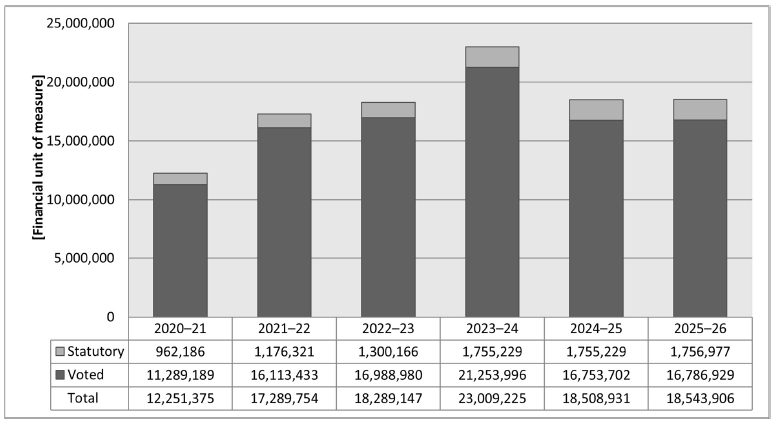
Text version of Figure 1
| 2020-21 | 2021-22 | 2022-23 | 2023-24 | 2024-25 | 2025-26 | |
|---|---|---|---|---|---|---|
| Statutory | 962,186 | 1,176,321 | 1,300,166 | 1,755,229 | 1,755,229 | 1,756,977 |
| Voted | 11,289,189 | 16,113,433 | 16,988,980 | 21,253,996 | 16,753,702 | 16,786,929 |
| Total | 12,251,375 | 17,289,754 | 18,289,147 | 23,009,225 | 18,508,931 | 18,543,906 |
The graph illustrates the Secretariat’s spending trends over a six-year period from 2020-21 to 2025–26. Fiscal years 2020–21 to 2022–23 reflect actual expenditures as reported in the Public Accounts. Fiscal years 2023–24 to 2025–26 represent planned spending.
The increased spending in 2023-24 is due to the expectation that the facilities fit-up and expansion is planned to be completed in this fiscal year.
The levelling of authorities in 2024–25 and 2025-26 is due to the sunsetting of funding earmarked for the completion of facilities fit-up and expansion.
Budgetary performance summary for core responsibilities and internal services (dollars)
The “Budgetary performance summary for core responsibilities and internal services” table presents the budgetary financial resources allocated for the NSIRA Secretariat’s core responsibilities and for internal services.
| Core responsibilities and Internal Services | 2022-23 Main Estimates | 2022-23 Planned spending | 2023-24 Planned spending | 2024-25 Planned spending | 2022-23 Total authorities available for use | 2020-21 Actual spending (authorities used) | 2021-22 Actual spending (authorities used) | 2022-23 Actual spending (authorities used) |
|---|---|---|---|---|---|---|---|---|
| National Security and Intelligence Reviews and Complaints Investigations | 10,756,818 | 10,756,818 | 10,757,687 | 10,757,687 | 11,541,004 | 3,009,066 | 7,394,642 | 7,756,271 |
| Subtotal | 10,756,818 | 10,756,818 | 10,757,687 | 10,757,687 | 11,541,004 | 3,009,066 | 7,394,642 | 7,756,271 |
| Internal Services | 17,493,858 | 17,493,858 | 7,701,336 | 7,701,042 | 17,822,513 | 6,643,579 | 9,895,112 | 10,532,876 |
| Total | 28,250,676 | 28,250,676 | 18,459,023 | 18,458,729 | 29,363,517 | 9,652,645 | 17,289,754 | 18,289,147 |
Human resources
The “Human resources summary for core responsibilities and internal services” table presents the full-time equivalents (FTEs) allocated to each of the Secretariat’s core responsibilities and to internal services.
Human resources summary for core responsibilities and internal services
| Core responsibilities and Internal Services | 2020-21 Actual full-time equivalents | 2021-22 Actual full-time equivalents | 2022-23 Planned full-time equivalents | 2022-23 Actual full-time equivalents | 2023-24 Planned full-time equivalents | 2024-25 Planned full-time equivalents |
|---|---|---|---|---|---|---|
| National Security and Intelligence Reviews and Complaints Investigations | 38 | 52 | 69 | 53 | 69 | 69 |
| Subtotal | 38 | 52 | 69 | 53 | 69 | 69 |
| Internal Services | 22 | 22 | 31 | 25 | 31 | 31 |
| Total | 29 | 60 | 100 | 78 | 100 | 100 |
Expenditures by vote
For information on the Secretariat’s organizational voted and statutory expenditures, consult the Public Accounts of Canada.
Government of Canada spending and activities
Information on the alignment of the Secretariat’s spending with Government of Canada’s spending and activities is available in GC InfoBase.
Financial statements and financial statements highlights
Financial statements
NSIRA’s financial statements (unaudited) for the year ended March 31, 2023, are available on the departmental website.
Financial statement highlights
Condensed Statement of Operations (unaudited) for the year ended March 31, 2023 (dollars)
| Financial information | 2022-23 Planned results | 2022-23 Actual results | 2021-22 Actual results | Difference (2022-23 Actual results minus 2022-23 Planned results) | Difference (2022-23 Actual results minus 2021-22 Actual results) |
|---|---|---|---|---|---|
| Total expenses | $28,250,676 | $19,585,699 | $16,164,825 | ($8,664,977) | $3,420,874 |
| Total revenues | 0 | 0 | 0 | 0 | 0 |
| Net cost of operations before government funding and transfers | $28,250,676 | $19,585,699 | $16,164,825 | ($8,664,977) | $3,420,874 |
The 2022–23 planned results information is provided in the Secretariat’s Future-Oriented Statement of Operations and Notes 2022–23. Future-Oriented Statement of Operations and Notes 2022–23
Condensed Statement of Financial Position (unaudited) as of March 31, 2023 (dollars)
| Financial information | 2022-23 | 2021-22 | Difference (2022-23 minus 2021-22) |
|---|---|---|---|
| Total net liabilities | $2,293,538 | $2,050,302 | $243,236 |
| Total net financial assets | $1,518,277 | $1,577,964 | ($59,687) |
| Departmental net debt | $775,261 | $$472,338 | $302,923 |
| Total non-financial assets | $4,829,722 | $2,240,138 | $2,589,584 |
| Departmental net financial position | $4,054,461 | $1,767,800 | $2,286,661 |
The 2022–23 planned results information is provided in the Secretariat’s Future-Oriented Statement of Operations and Notes 2022–23.
Corporate Information
Organizational profile
Appropriate minister: The Right Honourable Justin Trudeau, Prime Minister of Canada
Institutional head: John Davies, Executive Director
Ministerial portfolio: Privy Council Office
Enabling instrument: National Security and Intelligence Review Agency Act
Year of incorporation / commencement: 2019
Raison d’être, mandate and role: who we are and what we do
“Raison d’être, mandate and role: who we are and what we do” is available on NSIRA‘s website.
Operating context
Information on the operating context is available on NSIRA’s website.
Reporting framework
NSIRA’s Departmental Results Framework, with accompanying results and indicators, were under development in 2020–21. Additional information on key performance measures are included in the 2021–22 Departmental Plan.
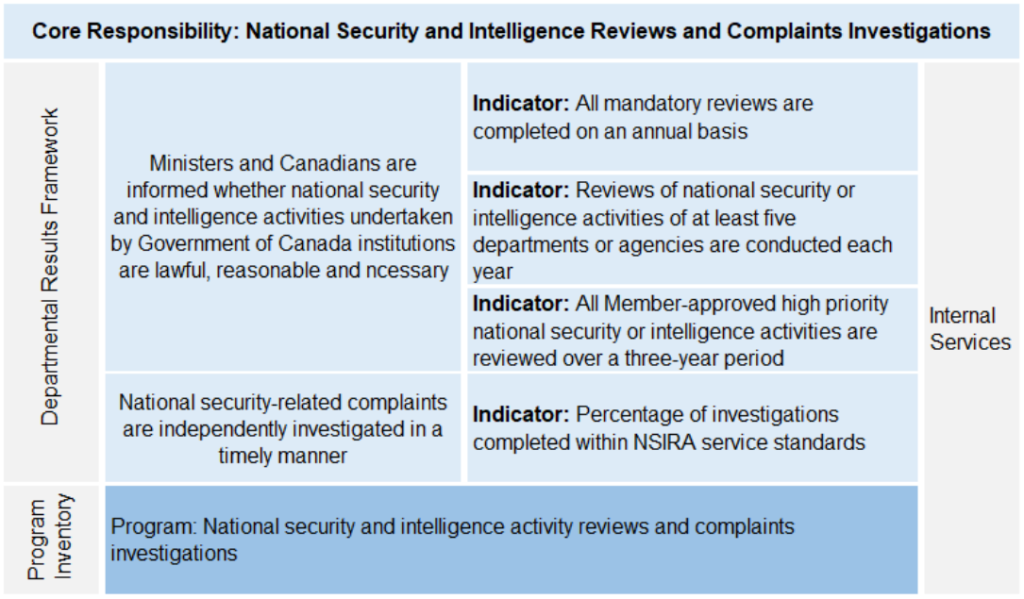
Text version of Figure 2
| Core Responsibility: National Security and Intelligence Reviews and Complaints Investigations | |||
|---|---|---|---|
| Departmental Results Framework | Ministers and Canadians are informed whether national security and intelligence activities undertaken by Government of Canada institutions are lawful, reasonable and necessary | Indicator: All mandatory reviews are completed on an annual basis | Internal Services |
| Indicator: Reviews of national security or intelligence activities of at least five departments or agencies are conducted each year | |||
| Indicator: All Member-approved high priority national security or intelligence activities are reviewed over a three-year period | |||
| National security-related complaints are independently investigated in a timely manner | Indicator: Percentage of investigations completed within NSIRA service standards | ||
| Program Inventory | Program: National security and intelligence activity reviews and complaints investigations | ||
Supporting information on the program inventory
Financial, human resources and performance information for NSIRA’s Program Inventory is available in GC InfoBase.
Supplementary information tables
The following supplementary information table is available on NSIRA’s website:
- Gender-based analysis plus
Federal tax expenditures
The tax system can be used to achieve public policy objectives through the application of special measures such as low tax rates, exemptions, deductions, deferrals and credits. The Department of Finance Canada publishes cost estimates and projections for these measures each year in the Report on Federal Tax Expenditures. This report also provides detailed background information on tax expenditures, including descriptions, objectives, historical information and references to related federal spending programs. The tax measures presented in this report are the responsibility of the Minister of Finance.
Organizational contact information
National Security and Intelligence Review Agency
P.O. Box 2430, Station “D”
Ottawa, Ontario
K1P 5W5
Appendix: definitions
appropriation (crédit)
Any authority of Parliament to pay money out of the Consolidated Revenue Fund.
budgetary expenditures (dépenses budgétaires)
Operating and capital expenditures; transfer payments to other levels of government, organizations or individuals; and payments to Crown corporations.
core responsibility (responsabilité essentielle)
An enduring function or role performed by a department. The intentions of the department with respect to a core responsibility are reflected in one or more related departmental results that the department seeks to contribute to or influence.
Departmental Plan (plan ministériel)
A report on the plans and expected performance of an appropriated department over a 3‑year period. Departmental Plans are usually tabled in Parliament each spring.
departmental priority (priorité)
A plan or project that a department has chosen to focus and report on during the planning period. Priorities represent the things that are most important or what must be done first to support the achievement of the desired departmental results.
departmental result (résultat ministériel)
A consequence or outcome that a department seeks to achieve. A departmental result is often outside departments’ immediate control, but it should be influenced by program-level outcomes.
departmental result indicator (indicateur de résultat ministériel)
A quantitative measure of progress on a departmental result.
departmental results framework (cadre ministériel des résultats)
A framework that connects the department’s core responsibilities to its departmental results and departmental result indicators.
Departmental Results Report (rapport sur les résultats ministériels)
A report on a department’s actual accomplishments against the plans, priorities and expected results set out in the corresponding Departmental Plan.
experimentation (expérimentation)
The conducting of activities that seek to first explore, then test and compare the effects and impacts of policies and interventions in order to inform evidence-based decision-making, and improve outcomes for Canadians, by learning what works, for whom and in what circumstances. Experimentation is related to, but distinct from innovation (the trying of new things), because it involves a rigorous comparison of results. For example, using a new website to communicate with Canadians can be an innovation; systematically testing the new website against existing outreach tools or an old website to see which one leads to more engagement, is experimentation.
full‑time equivalent (équivalent temps plein)
A measure of the extent to which an employee represents a full person‑year charge against a departmental budget. For a particular position, the full‑time equivalent figure is the ratio of number of hours the person actually works divided by the standard number of hours set out in the person’s collective agreement.
gender-based analysis plus (GBA Plus) (analyse comparative entre les sexes plus [ACS Plus])
An analytical process used to assess how diverse groups of women, men and gender-diverse people experience policies, programs and services based on multiple factors including race ethnicity, religion, age, and mental or physical disability.
government-wide priorities (priorités pangouvernementales)
For the purpose of the 2022–23 Departmental Results Report, government-wide priorities are the high-level themes outlining the government’s agenda in the November 23, 2021, Speech from the Throne: building a healthier today and tomorrow; growing a more resilient economy; bolder climate action; fighter harder for safer communities; standing up for diversity and inclusion; moving faster on the path to reconciliation; and fighting for a secure, just and equitable world.
horizontal initiative (initiative horizontale)
An initiative where two or more federal organizations are given funding to pursue a shared outcome, often linked to a government priority.
non‑budgetary expenditures (dépenses non budgétaires)
Net outlays and receipts related to loans, investments and advances, which change the composition of the financial assets of the Government of Canada.
performance (rendement)
What an organization did with its resources to achieve its results, how well those results compare to what the organization intended to achieve, and how well lessons learned have been identified.
performance indicator (indicateur de rendement)
A qualitative or quantitative means of measuring an output or outcome, with the intention of gauging the performance of an organization, program, policy or initiative respecting expected results.
performance reporting (production de rapports sur le rendement)
The process of communicating evidence‑based performance information. Performance reporting supports decision making, accountability and transparency.
plan (plan)
The articulation of strategic choices, which provides information on how an organization intends to achieve its priorities and associated results. Generally, a plan will explain the logic behind the strategies chosen and tend to focus on actions that lead to the expected result.
planned spending (dépenses prévues)
For Departmental Plans and Departmental Results Reports, planned spending refers to those amounts presented in Main Estimates.
A department is expected to be aware of the authorities that it has sought and received. The determination of planned spending is a departmental responsibility, and departments must be able to defend the expenditure and accrual numbers presented in their Departmental Plans and Departmental Results Reports.
program (programme)
Individual or groups of services, activities or combinations thereof that are managed together within the department and focus on a specific set of outputs, outcomes or service levels.
program inventory (répertoire des programmes)
Identifies all the department’s programs and describes how resources are organized to contribute to the department’s core responsibilities and results.
result (résultat)
A consequence attributed, in part, to an organization, policy, program or initiative. Results are not within the control of a single organization, policy, program or initiative; instead they are within the area of the organization’s influence.
statutory expenditures (dépenses législatives)
Expenditures that Parliament has approved through legislation other than appropriation acts. The legislation sets out the purpose of the expenditures and the terms and conditions under which they may be made.
target (cible)
A measurable performance or success level that an organization, program or initiative plans to achieve within a specified time period. Targets can be either quantitative or qualitative.
voted expenditures (dépenses votées)
Expenditures that Parliament approves annually through an appropriation act. The vote wording becomes the governing conditions under which these expenditures may be made.


